GÁL HUSZÁR (1558 - 1575)
Gál Huszár (1512?-1575) protestant preacher was among the first to use printing for the purpose of spreading the new confession. A learned scholar of theology, he acquired his skill in writing and preaching at the Cracow university. He belonged to the first generation of protestant priests in Hungary and in this capacity and as a school-master in Western Hungary he was patronized by the mighty noble family Thurzó.

ÓVÁR
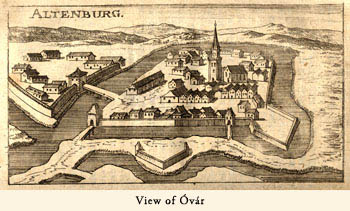 Gál Huszár settled in Óvár, a fortified town in Western Hungary, belonging to the private estate of the Habsburg family. In this part of Hungary the number of inhabitants converting from Catholicism to Lutheranism was quite considerable. To strengthen the position of the protestant church, Gál Huszár erected a printing press from the money lent to him by his patrons. He acquired his printing types, music notes and a part of the ornaments from one of the prominent printers and wood-cutters of Vienna,
Gál Huszár settled in Óvár, a fortified town in Western Hungary, belonging to the private estate of the Habsburg family. In this part of Hungary the number of inhabitants converting from Catholicism to Lutheranism was quite considerable. To strengthen the position of the protestant church, Gál Huszár erected a printing press from the money lent to him by his patrons. He acquired his printing types, music notes and a part of the ornaments from one of the prominent printers and wood-cutters of Vienna,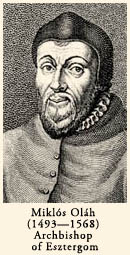 from Raphael Hoffhalter. To illustrate his books he used some ornaments of the previous printing shop at Sárvár-Újsziget, which had ceased its activity by that time. He has probably acquired these wooden blocks through the mediation of another protestant preacher and writer, Péter Bornemisza, later a printing shop owner himself. The fate of these three persons, including Hoffhalter, all engaged in writing and issuing books of protestant confession, continued to be combined for several years.
from Raphael Hoffhalter. To illustrate his books he used some ornaments of the previous printing shop at Sárvár-Újsziget, which had ceased its activity by that time. He has probably acquired these wooden blocks through the mediation of another protestant preacher and writer, Péter Bornemisza, later a printing shop owner himself. The fate of these three persons, including Hoffhalter, all engaged in writing and issuing books of protestant confession, continued to be combined for several years.
The first product of Huszár's press was a collection of his own preaches, dedicated to his patron Habsburg Archduke Maximillian on the 1st April 1558 (RMNy 151). As a retorsion, the Catholic bishop prohibited for him to print anything in the future. Still, he could issue the next year (1559) the satyrical, polemical piece by Mihály Sztáray, written agains t Catholic clergy (RMNy 158) as well as Heinrich Bullinger's letter of confession addressed to Hungarian protestants (RMNy 157).
To avoid further attacks from the Catholic bishop, he accepted the invitation from the City Council of Kassa and moved to this Upper Hungarian town.

KASSA
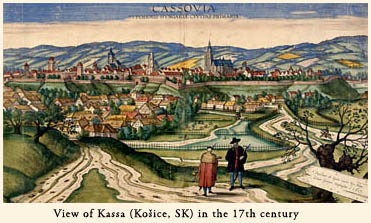 Protestant confession quickly spread among the partly German partly Hungarian inhabitants of Kassa. The town joined the "Confession of the Five Towns" founded together with the Upper hungarian tons Eperjes (Presov, SK), Lőcse (Levoca, SK), Bártfa (Bardejov, SK) and Kisszeben (Sabinov, SK), to defend their interests against Catholic authorities.
Protestant confession quickly spread among the partly German partly Hungarian inhabitants of Kassa. The town joined the "Confession of the Five Towns" founded together with the Upper hungarian tons Eperjes (Presov, SK), Lőcse (Levoca, SK), Bártfa (Bardejov, SK) and Kisszeben (Sabinov, SK), to defend their interests against Catholic authorities. 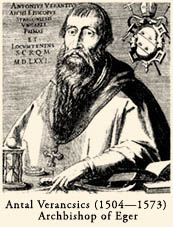 Gál Huszár began his activity as Lutheran priest of Kassa in March 1560. While in Óvár, he has also offered his service as a book-printer to his future community It can be supposed that he set up his printing press in Kassa and some leaflets might have left his press, although no such printing bearing his imprint survived. Still, his protestant community song book with musical notations, the unique copy of which was only recently discovered, proves that his printing press was active during his short stay in Kassa (RMNy 160). He began to print this song book compiled by hinmself in Óvár, and continued it in Kassa. However, he could not finish it in Kassa. He was arrested in the first days of October on the order of the Archbishop of Eger, Antal Verancsics.
Gál Huszár began his activity as Lutheran priest of Kassa in March 1560. While in Óvár, he has also offered his service as a book-printer to his future community It can be supposed that he set up his printing press in Kassa and some leaflets might have left his press, although no such printing bearing his imprint survived. Still, his protestant community song book with musical notations, the unique copy of which was only recently discovered, proves that his printing press was active during his short stay in Kassa (RMNy 160). He began to print this song book compiled by hinmself in Óvár, and continued it in Kassa. However, he could not finish it in Kassa. He was arrested in the first days of October on the order of the Archbishop of Eger, Antal Verancsics.
The citizens of Kassa wanted to rescue their priest and in fact, at Christmas-time in 1560 he successfully escaped from his prison. Both his family and the half-finished song book were safely conferred to the Eastern Hungarian market town Debrecen.

DEBRECEN
Thanks to his escape from Kassa, at the very beginning of 1561 he settled in Debrecen a market spot with Calvinist majority. 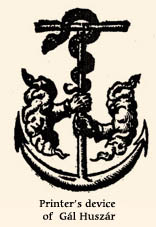 He set up his printing press again, and his safety was guaranteed by the town council of Debrecen. In return, Gál Huszár offered his service as a printer.
He set up his printing press again, and his safety was guaranteed by the town council of Debrecen. In return, Gál Huszár offered his service as a printer.
It was Gál Huszár who introduced printing in Debrecen. The first product of his press was the protestant song book began in Óvár and continued in Kassa. This book is not only the first product of the Debrecen printing shop, but also the first protestant song book in Hungarian language. It was dedicated by Huszár to the Calvinist bishop of Debrecen, to Peter Melius Juhász.
The first printing was soon followed by others (RMNy 169, RMNy 171, RMNy 181), mostly polemic works by Melius against Antitrinitarians, those belonging to the radical branch of protestantism. Early the next year, 1562 he began to print the confession of Eger, although it was not finished by him. He decided to return to Western Hungary and serve as priest in Komárom, where he apparently ceased his printing activity for some time.
|
|
Title page of the Debrecen protestant song-book with Kálmáncsehi's work annexed to it
RMNy 160 |
It can be supposed that when leaving for Komárom, he did not take his whole printing equipment with himself, but donated itt o the town of Debrecen - thus making it possible to find a printer and continue issuing books in Debrecen. It was very likely the Calvinist bishop Melius who realized the power of printed word and made efforts to make the printing activity continuous in Debrecen: both to defend his own church and to argue against Catholicism and Antitrinitarianism.
 |
A head-piece of the Komjáti protestant song-book decorated with natural foliage (RMNy 353) |

KOMJÁTI
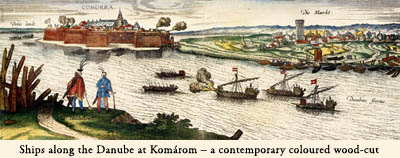
As a preacher Huszár was very successful in Komárom in converting the inhabitants from Catholic to Protestant confession. Therefore he was soon condemned by Archmishop Miklós Oláh and again, Huszár had to leave Komárom in the course of 1563. There is no trace of any printing activity carried on by Huszár in Komárom, the reason may have been partly his occupation as a priest and partly the insufficiency of his printing equipment.
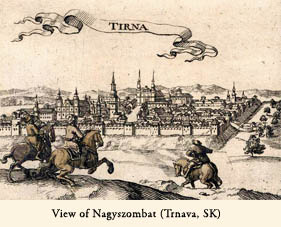 It was not only Gál Huszár who was condemned first by the Catholic authorities and later by the king Maximillian II, but Peter Bornemisza too, and as a consequence, their teachings were declared as heretic. However, this opportunity helped the two protestant preachers to plan some cooperation in order to unite their equipments and issue works promoting the spread of protesant confession.
It was not only Gál Huszár who was condemned first by the Catholic authorities and later by the king Maximillian II, but Peter Bornemisza too, and as a consequence, their teachings were declared as heretic. However, this opportunity helped the two protestant preachers to plan some cooperation in order to unite their equipments and issue works promoting the spread of protesant confession.
This mutual activity was realized some years later, at the turn of the years 172/1573 when the cooperation between the Komjáti respectively the Sempte printing shops began.
The new printing place, Komjáti was a small market spot in Upper Hungary, an estate of the Forgách family. It was Imre Forgách who patronized Gál Huszár, probably from 1568 on. Int he vicinity of Komjáti Peter Bornemisha settled as a priest, almost at the same time., patronized by the Salm and Thurzó families. 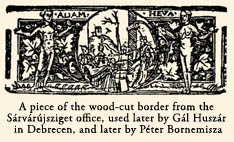 The two protestant preachers and printing press owners decided to set up a printing shop, as Bornemisza succeeded in collecting money from his patrons, being mostly protestant magnates. This way he could renew the old and poor equipment of Huszár by purchasing new type faces and ornaments in Vienna, either from Kaspar Stainofer himself or with his mediation.
The two protestant preachers and printing press owners decided to set up a printing shop, as Bornemisza succeeded in collecting money from his patrons, being mostly protestant magnates. This way he could renew the old and poor equipment of Huszár by purchasing new type faces and ornaments in Vienna, either from Kaspar Stainofer himself or with his mediation.
For a short time the two of them were printing together and shared the equipment (RMNy 333) , but soon they separated it to two parts and both were able to issue think voluemes of their own preaches. Gál Huszár, on his part, in 1574 printed the Christian preaches and prayers (RMNy 353), the finest piece of his printing achievements, the so-called Komjáti song-book with musical notations.
In 1575 he moved to the Transdanubian town Pápa, where he soon died in pest.
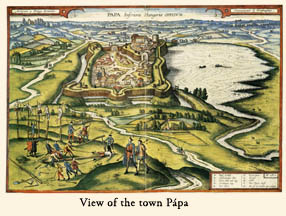

DÁVID HUSZÁR
Gál Huszár's eldest son, a school-master in Nagyszombat (Trnava, SK) had to leave the town because of the order given by the Catholic bishop, and moved to the safer place Pápa, where, after the death of his father, inherited his printing equipment. Soon the town of Pápa with a majority of protestant inhabitans became a printing site, as there were three books issued by Dávid Huszár in Pápa. All of them printed in 1577, in fact there is no evidence of his printing activity either before or after that date. These three printings were the first Hungarian translation of the Heidelberg Catechism (RMNy 395), the articles of the Calvinist Synod at Hercegszöllös both in Latin and Hungarian (RMNy 394)
|
|
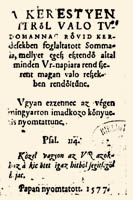 |
RMNy 393 |
RMNy 394 |
RMNy 395 |

INITIALS
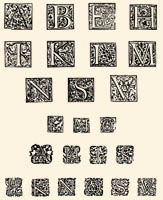

PRINTER’S FLOWERS

PRINTING TYPES

<<back to the top <<

LITERATURE:
BÁNFI Szilvia: Huszár Gál távozása Debrecenből, és nyomdakészletének további sorsa. = MKSz 1986. 1-16.
BÁNFI Szilvia: Huszár Gál komjáti nyomdája és nyomdafelszerelésének eredete. In. Gesta typographorum. A hetvenéves Borsa Gedeon tiszteletére. Bp. 1993. 28-49.
BORSA Gedeon: Az elveszett és megkerült mű. Bp. 1983. (Kísérő tanulmány az énekeskönyv hasonmás kiadásához, BHA XII.)
BOTTA István: Huszár Gál élete, művei és kora (1512-1575). Bp. 1991.
V. ECSEDY Judit: A régi magyarországi nyomdák betűi és díszei 1473-1600. Bp. 2004. 385-401.